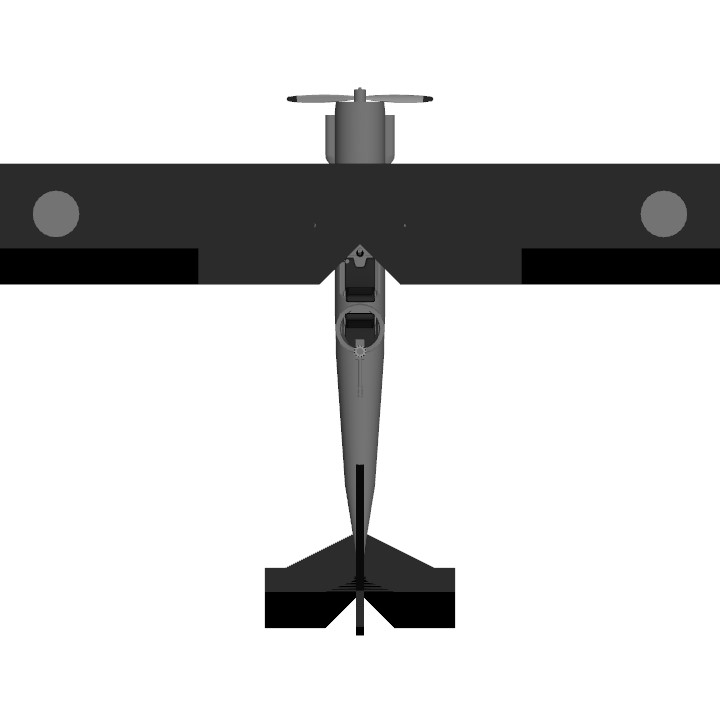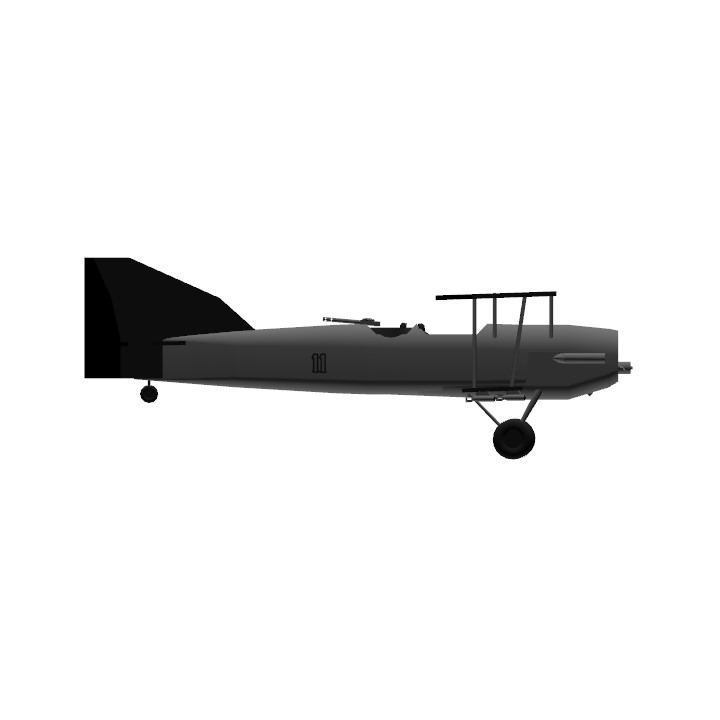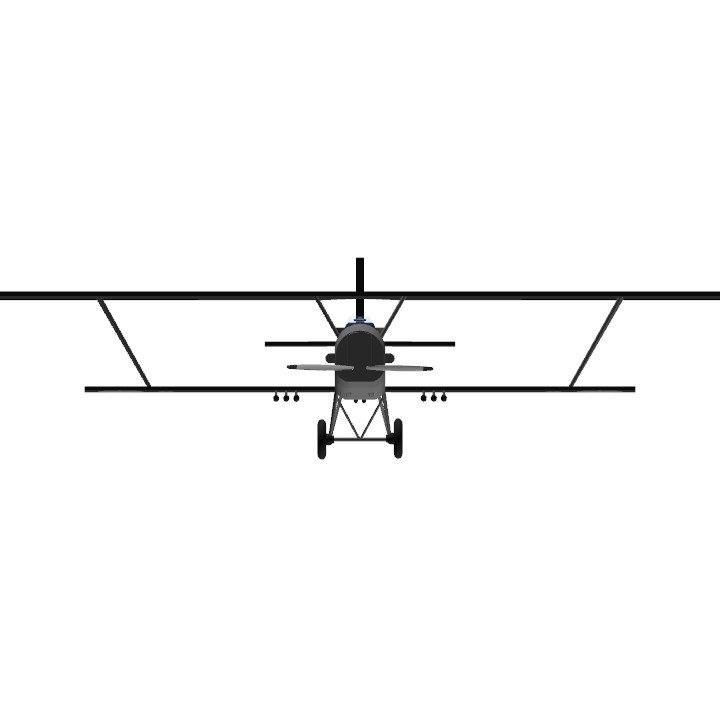Hello there, this is my second challenge aircraft so expect quality issues.
This Potez 25 is a light multirole french aircraft, designed in the 1920's, however this is a variant used by Paraguay during the Chaco War(1932-1935).
Controls:
AG.-1: Drop all bombs.
AG.-2: Activate offensive guns.
AG.-3: Activate defensive gun(turret doesn't work T~T).
AG.-4: Activate Auto Stability(recommended to use when the plane enters a stall or a spin).
Guide and tips:
*This is a rather unstable plane, so it'll take some practice to fly.
-Take off: Throttle up and go foward until you reach about 120 km/h, then pull up and be careful not to bank the plane since it can stall and crash.
-Flying: It's a very simple plane, its biplane layout makes it decently maneuverable and it can reach around 230 km/h.
-Combat: Although your maneuverability is decent for air combat, is not as good for a biplane, also since it's a bit unstable you may need to practice with it. Bombing is rather easy, just be sure not to drop the bombs below 250 meters of altitude.
-Landing: It's stall speed is rather high, again, this makes landing a bit difficult, but it's still slow enough for most aircraft so yeah, just be careful not to brake a lot since it can belly flop.
Specifications:
*Top speed: 230 km/h(limit: >300 km/h).
*Maneuverability: Decently agile, but unstable, be careful on dogfights.
*Weaponry: x2 7.7 mm offensive machine guns, x1 7.7 mm defensive machine gun, x12 60 kg bombs.
-Stall speed: 120 km/h
-Climb rate: 3.5 m/s
-Service ceiling: 5500 meters
-Crew: 2
-Range: 214 km
-Engine power: 420 HP
Now, a little bit of History
I've published this airplane on 12th june 2022, the same day Paraguay and Bolivia declared peace after the Chaco War, conflict at which the Potez 25 fought on.
The variant shown here is a Potez 25 TOE, the most produced by France and the most numerous on the Paraguayan Air Force during said conflict, since it was a multirole fighter, and Paraguay having a relatively small air force, we used it on purposes beyond just combat, such as reconnaissance and even cargo.
However, there is conflict on the first air-to-air encounter on the Americas:
*According to Paraguayan reports, this occurred on 28 September, when a Paraguayan Potez 25 encountered a Bolivian Vickers Vespa. The Paraguayan pilot, Lieutenant Emilio Rocholl, was wounded but able to return to base with his aircraft.
*According to Bolivian accounts, the first aerial combat on the Americas between belligerent nations occurred on 4 December 1932, over Saavedra. The victor was Bolivian pilot Rafael Pabón, who shot down a Paraguayan Potez TOE Nº 6. This was the pilot's only victory against a Paraguayan aircraft, despite Bolivian claims of other two victories. While he was seeking a second victory, he was taken out by a Potez 25 TOE N° 11, dying there with his gunner on 12 August 1934 near Fort Florida. Upon discovering the identity of the pilot, the Paraguayans paid the dead pilot great honours.
Between 9 and 29 September, Paraguayan Potez 25s, escorted by Wibault 73 fighters, carried out 12 bombing raids against Bolivian troops in Boqueron. The Paraguayans also used their radio-equipped Potez 25s to direct artillery fire from their Schneider 75 mm batteries.
The Paraguayan army would lose another Potez 25 to Bolivian planes on 12 December 1934 over Capirenda, when a Hawk escorting a Junkers K 43 shot down Potez TOE Nº 13 after a brief exchange of fire. Both pilot and gunner survived the crash. The conflict would see the last ever dogfight between biplanes, over the Bolivian stronghold of Ballivián. The Potez 25 would be the only type of aircraft from either side to be used during the entire conflict.
Paraguayan planes would drop water to their own thirsty troops in the form of ice blocks. The Potez 25 played the role of transport aircraft during the first and second battles of Nanawa, when they replenished the depleted Paraguayan stockpiles with hand grenades and ammunitions. The four Potez 25s involved in the operation were stripped of their rear machine guns in order to use the gunner's cockpit to load 115 kg of ammunition. The aircraft departed from Isla Poí to the south over Bolivian-controlled areas. On the first day only, they delivered 1,650 kg of ammunition on a hastily built runway. Three of the planes were hit by ground fire and forced to make emergency landings, but all of them were recovered and shipped to Asunción, where they endured a major overhaul.
General Estigarribia used light aircraft extensively for liaison throughout the region, and to meet with his commanders. Estigarribia also used light aircraft to conduct his own reconnaissance of the front lines. The Paraguayan president Eusebio Ayala was also airlifted to the front in several occasions, often on the multi-use Potez 25, to visit the troops and meet with Estigarribia.
Paraguay fielded 32 combat aircraft and 23 trainers and transports. Per official Paraguayan statistics, during the war Paraguay lost nine aircraft (two Wibault 73s, four Potez 25, a CANT, and two Fiat CR20), and Bolivia lost ten (six Osprey, a Junkers, a Hawk, and two Curtiss Falcons). The main cause of these combat losses was ground fire. Air-to-air combat was relatively rare. However, when the air forces came face to face aggressive combat occurred between fighter aircraft, such as a rare clash between a Paraguayan Potez 25 bomber and two Bolivian Breguet XIX bombers.
On some occasions, there were successful attacks on enemy airbases and supply dumps. The most successful Paraguayan air raid of the war took place on 8 July 1934 against the landing strip and supply dump at the Bolivian fortified base of Ballivián. Four Potez 25s, escorted by Fiat fighters, dropped 40 bombs on the airstrip and damaged at least seven parked Curtiss combat planes, as well as depots and other facilities. The Potez also attacked and destroyed the main fuel dump. Two Uruguayan Army pilots, Lieutenants Benito Sánchez Leyton and Luis Tuya, played a key role in the raid on this Bolivian stronghold.
Thanks for reading this far, I hope you have a fun time flying this airplane, this has taken me like 3 or 4 days to make because of homework, and perfecting it took a whole week since I wanted it to fit most of the specifications the real one had, sadly I couldn't make it have a shorter take off run, I hope I can make better aircraft in the future, Cya later.
¡PARAGUAYOS, REPUBLICA O MUERTE!
Specifications
General Characteristics
- Predecessor Pre-WW2 Challenge (CLOSED)
- Created On Windows
- Wingspan 29.3ft (8.9m)
- Length 22.2ft (6.8m)
- Height 8.1ft (2.5m)
- Empty Weight 4,121lbs (1,869kg)
- Loaded Weight 4,442lbs (2,015kg)
Performance
- Horse Power/Weight Ratio 0.095
- Wing Loading 18.1lbs/ft2 (88.3kg/m2)
- Wing Area 245.5ft2 (22.8m2)
- Drag Points 3011
Parts
- Number of Parts 140
- Control Surfaces 9
- Performance Cost 745




